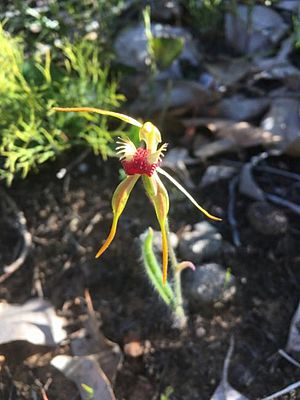Big clubbed spider orchid facts for kids
Quick facts for kids Big clubbed spider orchid |
|
|---|---|
 |
|
| Caladenia magniclavata growing near Donnybrook | |
| Scientific classification | |
| Genus: |
Caladenia
|
| Species: |
magniclavata
|
| Synonyms | |
|
|
The Big Clubbed Spider Orchid (Caladenia magniclavata) is a special type of orchid. It grows only in the south-west part of Western Australia. This unique flower has a single, hairy leaf. Its pale yellow-green and red flowers look a bit like spiders. They have parts called sepals and petals that have thick, club-like tips.
Contents
The Big Clubbed Spider Orchid
What Does It Look Like?
The Big Clubbed Spider Orchid is a plant that grows in the ground. It is a perennial, meaning it lives for more than two years. It's also deciduous, so its leaves fall off at certain times. This plant is a herb with a tuber (a swollen underground stem) that stores food.
It has one straight, hairy leaf. This leaf can be from 100 to 300 mm (4 to 12 in) long and about 2 mm (0.08 in) wide. The plant grows up to three flowers on a tall stalk. This stalk can be 300 to 600 mm (12 to 24 in) high.
The flowers are pale yellow-green and red. They are about 50 to 80 mm (2 to 3 in) long and 50 to 60 mm (2 to 2.4 in) wide. The sepals and petals of the flower have thick, club-like tips. These tips can be 6 to 25 mm (0.2 to 1 in) long. The top sepal stands upright. The side sepals and petals point downwards.
The labellum (the orchid's special lip petal) is greenish yellow with a red tip. It is about 12 to 14 mm (0.5 to 0.6 in) long and 10 to 12 mm (0.4 to 0.5 in) wide. The labellum's tip curls under. It has teeth up to 4 mm (0.2 in) long along its edges. In the middle of the labellum, there are four rows of small, deep red bumps called calli. These calli are about 1 mm (0.04 in) long. This orchid blooms from September to early November.
How It Got Its Name
The Big Clubbed Spider Orchid was first officially described in 1947. A botanist named William Nicholls wrote about it. His description was published in a magazine called The Victorian Naturalist.
Its scientific name, magniclavata, comes from two Latin words. Magnus means "large" or "great". Clava means "club". This name refers to the large, club-shaped tips on the sepals and petals of the flower.
Where Does It Live?
You can find the Big Clubbed Spider Orchid in the area between Perth and Albany in Western Australia. It grows in dense Jarrah and Karri forests. These forests are found in specific natural regions of Australia.
Is It Safe?
The Western Australian Government's Department of Parks and Wildlife has classified Caladenia magniclavata as "not threatened". This means it is not currently at risk of disappearing.

